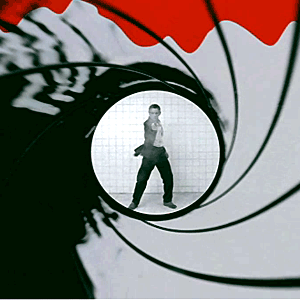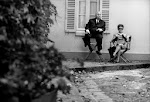


The new James Bond Film Casino Royale, is breaking all Box Office records. Everything Bond has been put under the microscope; from Daniel Craig’s impersonation of Ursula Andress coming out of the water to ‘How to be like Bond with the new Sony VAIO’. And of course it gave all other Media an opportunity to present their perspective of what or who is Bond.
Channel 4, the Champion of Chart shows, ‘MORI polled’ the UK’ favourite Bond music. It may have looked like just another popular TV Chart show, but as marketers we should have recorded this programme and watched it over and over in order to understand and grab a whole new dimension of branding.
It was a marathon 2 hours of programming, The producer’s quest to understand what makes a ‘Bondesque’ sound was relentless. The man himself, John Barry clearly understood the key values of Bond and what makes a track fit with that image. But if Bond is a brand, how can the principles of writing a Bond soundtrack be applied to the world of marketing? To begin to understand this, we first need to put Bond under the music spotlight in order to begin to identify the key characteristics, which go to make up a Bond theme song.
What or who is Bond? What are the characteristics and values that define the fundamental elements of Bond. It seems that Bond is a series of contradictions; seductive and romantic yet steely; sophisticated but primal ; classy and elegant but with a surprising punch and brutality that creeps up and explodes into action. He is very cool but very British and yet has a unique ability to blend on an international level.
Bond Original
The original signature James Bond theme, was written by Monty Norman and arranged by John Barry for 1962’s Dr. No, and is without doubt, one of the most instantly recognizable film songs. The first few seconds hold the four ominously subdued notes forever associated with the man himself: first B, then up a half-step to C, up another half step to C#, then back down to C. This simple chromatic rise and fall creates a sense of unsettling mystery, as if the music is pacing back and forth, frantically trying to decide where to go next. The riff we all recognise is a small musical phrase that appears time and time again, throughout the film score. In Classical music this phrase is called a ‘leitmotif’.
As the guitar riff (played by legend Vic Flick) enters and firmly roots us in the key of E minor, its melody is atypical. The high D# jumps up to stab like a knife. Though this note is still a member of the E melodic minor scale, in a traditional melody the D# would lift up to an E instead of sliding down and hanging on the D natural. It’s another subtle way Norman and Barry have crafted surprise and mystery through melody.
Finally, after the blaring trumpets have entered and fully developed the theme, they burst into a swung, ornamented variation of the opening guitar riff. But it’s not as straightforward as it seems. A careful ear will notice that the second trumpet seems to be playing in a different key. In fact, this ‘harmonized’ melody, sandwiched between the top trumpet and the bass, would actually feel more at home in the key of C# minor than E minor.
Where the original theme from Dr. No remains in the key of E minor, Goldfinger’s moves across the boundaries of key signature constantly, sometimes in the same bar!
These apparent breaks in musical ‘rules’ are inherent in Bond melodies, but then again, since when has Bond been about following the rules? And if that is the case does the music follow the same anarchic patterns?
Of course over the four decades of music, there have been new production techniques and modern trends in music and fashion. In fact, the whole series of Bond music can be studied as a microcosm of the progression of pop music in the last half-century. But it would appear that in order for any Bond theme to work with the film and image of Bond there have always been clear consistent elements that say to the listener, “Now that’s what I call Bond music!”
Bond Basics
Those early instrumentation probably are the best examples of pure Bond music signposts. Firstly, we see the use of a powerful brass section to punch out main riffs and annunciate the ‘answering phrases’. We hear examples of this in Dr. No, Goldfinger, and Thunderball; all have imposing brass orchestration, which adds to the sassy/suave glamorous feel.
Next we have the string section, used to give the song an emotional depth. From the free-flowing opening of From Russia With Love to the seductive sweeps in The World Is Not Enough. Nothing says class or romance like a rich string arrangement.
To complete the set, distinctive percussion should punctuate every inch of the theme; and although some of the more recent songs have scaled back to a standard drum kit, the ‘classic’ Bond songs always include the full orchestral percussion outfit, Congas in Live & Let Die, Jingle Bells in Goldfinger, Marimba in You Only Live Twice, and not to mention a staple diet of Timpani, Crash Cymbals, and Vibes.
Top it off with a few final garnishes that help to build the Bond image. The distinctive Vic-style guitar, the bond ‘leitmotif’ (placed wherever possible) and a Female Diva or Male Superstar with the versatility, to move from seductively quiet introductions to powerfully epic climaxes.
New Bond
It is so tempting with a new Bond every few years to reinvent the product, sometimes making change for change sake. So how well have the most recent guardians of the Bond music, the new composers and producers, succeeded in staying true to the Bond inherent values and branding?
On the surface the new Casino Royale theme song You Know My Name sung by rock musician Chris Cornell (Soundgarden, AudioSlave) and written and produced by David Arnold., doesn’t seem to musically quote any of the ‘classic’ themes, as done very directly in Goldeneye and License to Kill. But listen a little more closely and you will find them
Remember the common-chord modulation used to surprise the audience? Cornell uses this technique multiple times in the track. During the verses, a B minor chord changes to a G minor chord. During the chorus, G major becomes E major. Both these chord changes keep listeners on the edges of their seats. Remember the oddly harmonized trumpets in the original theme. This technique is back in Cornell’s vocal doubling; one voice sings in the key of B minor while the other is found in D minor.
But in terms of orchestration, You Know My Name lacks the more obvious instruments of past themes. The trumpets and strings are present, but only as a sparse backdrop to Cornell’s mountain of guitar. Like several of the more recent songs, the percussion is limited to a standard drum kit, with a bland backbeat indistinguishable from a typical pop song. And the choice of the raw-sounding Cornell as a vocalist is a far cry from the smooth British Matt Monroe or Tom Jones. The song’s packaging is strong enough to place it on the charts, but only time will tell if the Bond elements are strong enough to place it on the Bond theme favourites list ten years from now.
Traditional values in a New World
So what makes great Bond track and what other factors will help us define the general public’s response and recall? The tracks that found themselves lower down in the MORI poll all contained the classic Bond elements at some level or other and some the added bonus of pop video support and more than a sprinkling of the best record selling artists in the country- Aha, Duran Duran and Madonna?
There has been considerable research into the key indicators in music that affect the way we receive and process music. We ‘understand’ at a very primal level that certain instruments evoke certain emotions. Add strings and a composer can bring romance or sadness to the piece; change the key from major to minor and even the most musically illiterate sense the change. Why are some songs more important to us than others; why can we remember every lyric to a particular artist; cry to some songs without even knowing consciously that we are listening.
Quite simply when we hear music the brain starts to look for markers that it knows and understands - associated values, like times when it heard something similar, places, people etc. If we keep hearing those markers with the same or similar visual markers we understand, we remember and we have an expectation.
Success in the Music Industry is still measured by chart positions and this is normally the main objective. Being a number 1 is great for the short term, but will it say the same in 10 years time? You may get a hit track, but you won’t necessarily get a Bond track? Yet if writing formulaic music were the answer, the Music Industry would be a lot more successful than it is. The truth is that there are multiple variables that come into play, like most importantly, whether the song is actually any good!
Forty-four years on, the adaptation and modification of the Bond markers to reflect each new and contemporary Bonds have created many successes and as the Channel 4 poll reveals, many failures. Wander too far away from the key elements and values and the public simply gets confused.
However different it may be from the ‘classic’ Bond sound, You Know My Name is a product of its time, just as the original Bond theme was forty-four years ago. For Marketers, it raises the important question: can a brand’s music stay true to its roots while still being fresh and current?
Clearly, a classic sound can be tinkered with, sometimes successfully, sometimes unsuccessfully. Only through a real appreciation of the principle brand values, musical ingenuity and unique orchestration can a Bond song become timeless, which poses a challenge to Bond composers and indeed those responsible for safeguarding the sound of any brand. The desire to create something new for an established brand is very seductive but evidently the need to retain the core integrity of the brand is essential.
So just as the ‘credits’ roll, a few words of advice to whomever wants to write the next James Bond theme song. Remember that a classic Bond song is more than a pop hit. Remember the giants on whose shoulders you’re standing, and remember to keep it Bond…James Bond.


































